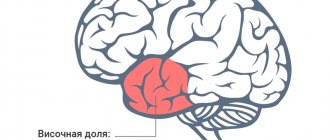Our brain is a complex mechanism that is responsible for performing various tasks. Essentially, it is a biological computer in which physiological and psychological processes, such as memory, occur. Most people confuse or interchange the concepts of “memory” and “memorization.” However, this is a misconception. Memorizing information is the imprinting of specific material; if we continue the parallel with the computer, then it is writing data to the hard drive. This article is devoted to this property of memory.
- Types of memorization
- The main conditions for successful memorization
- Some facts about memorization
Loci method
The name of this method comes from the Latin word locus - “place”. It also goes by a number of other names: spatial mnemonics, memory palace, mind palace, mental walk.
It is generally accepted that the method of loci originated in ancient Rome thanks to orators who had to keep all the information in their memory for many hours of speeches. The essence of the method is visualization, linking facts that need to be remembered to well-known locations. Facts can include anything: foreign words, a shopping list, people’s names, etc.
How does the method of loci work? Imagine that you are standing in your home (memory palace). Walk through the house mentally, taking note of its distinctive features—they can be used to store information you want to remember. Each stop on your way will be the very “locus” to which you can attach an idea or object. For example, the front door can be one locus, the bedside table in the hallway can be a second locus, and the lamp in the living room can be a third. If you need to remember a word, create an association between that word and one of the objects in the house. Record this in your head. When you think about your memory palace, you will remember not only the route, but also the objects associated with the locations.
Some facts about memorization
The art of successful memory retention is, to some extent, work. However, there are specific conditions for this. Let's look at some patterns of memorization.
- Trivial events in life, which leave a particularly vivid impression, are stored in the head immediately and for a long time, and years later are retained in the mind clearly and clearly.
- Events that do not make a strong impression, even if repeated several times, will be remembered partially or not at all.
- There is the concept of “edge effect,” in which the beginning and end of a memorized row are better recreated.
- The number of repetitions needed for memorization is reduced in the case of increased attention to the memorized information. However, lack of attention cannot be compensated for by increasing the number of repetitions.
- The material in which the individual is especially interested will be remembered without effort. In adulthood, this pattern appears more clearly.
- Extraordinary and surprising impressions are recorded better than common and ordinary ones.
- The new experience gained by a person will not remain isolated in memory. By entering into an associative connection with other impressions, it can change or influence them in some way.
So, the processor located in a person’s head is an incredibly complex device that performs various tasks. We tried to highlight one of these problems in the article. Fulfilling specific conditions, comprehending the information received, weaving it into logical networks, as well as repeating what has been learned promise to fix the necessary knowledge in memory.
Mnemonics
This method is a set of techniques and methods that simplify the memorization of various information. It usually requires more effort to use effectively, but is better used in situations where you need to remember things like lists or structures. For example, if you need to remember a list of medications of a certain type, mnemonics will help you do this better than other methods.
Mnemonics is based on the formation of associative series and sequences when a person replaces abstract objects with real concepts. The main thing is to use bright, interesting associations.
In mnemonics, there are several most well-known techniques:
- Acronym: You make a combination of letters that “encrypts” the complete information for memorization.
- Acrostic: You create a poem in which the initial letters of the lines form a word.
- Keywords: You highlight key words in phrases. By remembering them, you restore the entire phrase in your memory.
- Rhyming: You make up rhymes to help you remember words or numbers.
- Image-name technique (suitable for remembering names): you come up with any clear connection between a person’s name and his physical characteristics.
- Chaining: You create a story in which the word or thought you want to remember causes a chain reaction and draws the next words with it.
Chunking method (crushing, fragmentation)
This method involves combining several elements that need to be remembered into one small group. Many people use it when trying to remember phone numbers or bank account numbers, but this method can be used for other types of information. The chunking approach is often reflected in the way we write phone numbers - with a dash. We do it this way in order to better perceive a set of numbers and remember them faster. Is there a difference between the perception of a set of numbers: 89265660000 and 8-926-566-0000? Of course have.
The key principle that makes this technique work is the combination of items based on semantic encoding, that is, items are placed into small groups according to context or some kind of pattern.
For example, some may group their grocery list alphabetically, others by food type. In any case, this method is only successfully implemented when you identify the most natural patterns for yourself and follow them.
Remembering, saving, recognizing, reproducing, forgotten
Thanks to sensation and perception, a person can save the most important information in order to use it in his life.
To do this, a person has the ability to remember and reproduce everything that he learns about the world around him. This is possible because we have memory. Memory is a person’s ability to retain their knowledge and experience and use them in their life. Of course, not everything that has to do with us is necessary to ensure a normal human life. Memory is a very important ability. Without it it is impossible to learn anything. After all, learning means not only learning something new, but also being able to repeat it. And for this you need to remember, preserve what you have learned. In Ancient Greece, there was even a goddess of memory, Mnemosyne. Mnemosyne means "memory" in Greek. Therefore, memory processes are also called mnemonic processes. Memorization that occurs without any effort, of course, is called involuntary memorization. First of all, something important, or interesting, or something that a person liked is involuntarily remembered. Indifferent and uninteresting things are usually not retained in memory. Something important and interesting for each person can be something different. Therefore, different people observing the same event may remember it differently. But a person is able to remember not only what is interesting to him or makes a vivid impression. A person can control his memory and make special efforts to remember. At the same time, he sets himself the goal of remembering something, learning something, and tries to do it. Such memory is called arbitrary. Memorization that occurs through special efforts, at the request of a person, is called memorization. When a person is born, he does not yet know how to manage his memory. A small child has involuntary memory. But gradually, along with involuntary memory, a person also develops voluntary memorization. If we set ourselves special goals and objectives to remember what we need to remember, then we turn memorization into memorization. This means that memory becomes more and more arbitrary. In this case, you can use special learning tools. They help you remember better and faster. Accurate memorization and memorization can also be different. After all, our memory has one significant feature. We remember better what we understand well. Therefore, when memorizing any material, each person must first understand the meaning of what he wants to remember. Memorization that is based on understanding the material is called meaningful memorization. Meaningful memorization allows us to convey the essence of what we have learned (“in our own words,” with an understanding of what we are talking about). However, a person can remember something without understanding it. In this case, he acts like a machine and simply mindlessly repeats the memorized material. As a result, the material is “imprinted” into memory. This kind of memorization is called rote memorization, or cramming. At school during lessons, at college, university, and academy during lectures, we have to memorize a lot on purpose and even learn it by heart. The most common way to memorize is to repeat the material over and over again. We often hear the saying: “Repetition is the mother of learning” - it is precisely about this method of memorization. But in learning, meaningful memorization is very important. To make memorization meaningful, you need to think about what you need to remember. To do this, you can mentally imagine what is being discussed and analyze it. If you need to remember a large text, you should break it into parts, highlight the main idea in each part, draw up and write down an outline of the text. The plan will serve as the basis for memorizing the material and subsequent presentation. After all, we remember not just to keep something in memory, but to remember it at the right moment. It is often difficult for a person to remember something specifically, and there is no way to use notes. To make memorization easier, people have come up with different ways. These are called memorization techniques. or ways of remembering. Convenient ways to remember. * 1. Rhyme technique. Any person remembers poetry better than prose. * 2. Composing phrases. To better remember scattered material, it can be combined into one general phrase. * 3. Reception of “places”. This technique allows you to remember a list of things by placing each of them in its place. It is convenient to write down the days of the week in the form of a diary page. Then some important matter can be mentally written down in this “diary” in the right place. * 4. “Grouping” technique. You can easily remember what items to put in your briefcase or bag. To do this, you need to mentally combine them into several groups. Using these and other techniques helps you remember important information easily and firmly. Everything that a person remembers is stored in his memory. But retention distinguishes between short-term memory and long-term memory. They differ from each other in two main properties. The first is the storage time of information (how long what we remember is not forgotten). The second is the amount of memory (how much information can be stored). Short-term memory. Its very name suggests that information is not stored for long and is then forgotten without a trace. Short-term memory stores information that a person needs for the time he is working with it. Therefore, short-term memory is also called working memory. The capacity of short-term memory is limited. It retains very little material. Special memory experiments have shown that the capacity of short-term memory is approximately 7+ - 3 elements. Long-term memory begins to work when a person sets a goal to remember something for a long time. This is especially necessary for preserving such knowledge that may be useful in the future. A person remembers for a long time what is very important and interesting to him. We remember so much because the volume of long-term memory is not limited. The more we repeat the material that we remember, the longer it is stored in our memory. How we remember what we forget Those objects and phenomena that a person perceives are stored in his memory. And then they are reproduced in the form of performances. A concept is a mental image of an object. It arises for us when we do not perceive the object itself. Based on ideas, what is stored in memory is reproduced and remembered. Representations help you recognize what you have already encountered before. Each person's ideas arise with varying accuracy and vividness. Different people may have different images. Each person has their own, special, unique images. The images that arise in one person may differ from the images that arise in other children. They depend only on the person’s personal experience. From what he himself saw, heard, felt, touched, tried. All of a person’s previous experience is added up and generalized in a representation. It is ideas that help us retain knowledge about a subject throughout our lives. Memory is not only the processes of remembering and storing information. it is also a process of forgetting. When we forget, we get rid of a lot of useless information and only important, essential information is left. However, unfinished actions are forgotten more slowly and are remembered longer than completed actions or any tasks. Types of memory Human memory can be very different. It is associated with various areas of a person’s life, with his characteristics and abilities. We all know how to perceive, move, think, feel. And in all actions and actions, memory helps us preserve skills, abilities, feelings, and not learn again each time. There are two types of memory: genetic (hereditary) and lifetime. Hereditary memory stores information that not only determines the anatomical and physiological structure of the organism during development, but also the innate forms of species behavior (instincts). Information stored in encoded form in DNA molecules is protected quite reliably from damage. Lifetime memory is a repository of information acquired from birth to death. The following types are distinguished: inbreeding (imprinting), as well as motor, emotional, figurative and symbolic memory. * Imprinting is a type of memory observed only in the early period of development, immediately after birth. Imprinting consists of the instantaneous establishment of a very stable specific connection between a person or animal and a specific object in the external environment. This connection persists for a long time, which is considered an example of learning and long-term memorization from a single presentation. It is believed that in humans, imprinting is observed until the age of 6 months (Ponugaeva A.G., 1973), however, there is reason to believe that this period in a child is much longer. John Bowlby believes that the artificial alienation of children from their mother as a warm, affectionate and attentive person is dangerous, at least until the age of three. Three months of “deprivation of love” (emotional deprivation) in this time interval is enough for changes to occur in the human psyche that cannot be completely eliminated in the future (increased aggressiveness, anomalies in social behavior). From a biological point of view, the relationship between mother and infant should be considered as an attachment system, including both emotional and behavioral reactions. The attachment system clearly increases the infant's chances of survival by allowing the immature brain to use the mature functions of the parents to organize its own life processes. In the first 2-3 years of life, when the relationship with the mother is so important, the child operates mainly with procedural memory. Declarative memory appears much later. Thus, infantile amnesia leads to the fact that we retain only a few childhood memories. * Memory and our senses We can remember what spring flowers look like, the noise of a plane flying in the sky, what a cat’s fur feels like, what niches our favorite candies smell like and what they taste like. Figurative memory helps us with this. Figurative memory is the memory of images that arise in a person when accepting the world around him. Figurative memory is associated with our senses. in those organs with which we perceive the world around us. Humans have five sense organs. According to our senses, there are five types of figurative memory: visual, auditory, olfactory, gustatory and tactile. Different types of figurative memory are developed differently in each of us. For some, visual memory predominates, for others it is auditory, olfactory, tactile, etc. In addition to figurative memory, which preserves images of perception, there are other types of memory. Motor (or motor) memory allows you to remember various movements. It helps develop skills and habits. If it were not for this type of memory, then each time we would have to relearn how to walk, hold a spoon, and write with our hands. It is motor memory that allows us to make many movements without thinking about them. There is emotional memory. We remember our feelings, emotions, experiences. Every person also has a logical or semantic memory. Logical memory allows us to remember our thoughts and reflections. Symbolic memory is memory for abstract, abstract, symbolic material. It is divided into verbal and logical. Verbal memory can contribute to the transformation of the visual image. The correct choice of words when formulating questions is important for the accuracy of the answer. Verbal memory is formed in ontogenesis following figurative memory and reaches its full development by 10-13 years. Unlike figurative memory, it is characterized by greater accuracy of reproduction. Features of logical memory are manifested in remembering only the meaning of the text, i.e. the text is processed in generalized concepts. Logical memory is closely related to human thinking. David Shaffer, in his book Children and Adolescents: Developmental Psychology, notes that as children's knowledge base increases, their memory span expands. Knowledge is power, and the more a child knows about a certain topic, the more he or she will be able to learn and remember. Detailed general knowledge can lead to increased memory efficiency, since the better the information is fixed in the child’s head, the easier it is to activate and comprehend it. (Bjorklund, 1987; Kee, 1994). Typically, older children know more about many topics than younger ones, and therefore spend less mental effort activating their knowledge, which leaves them more mental space to perform encoding, classification and other cognitive operations with new material [3, p.416-417] . Four major factors that contribute to the development of learning and memory. 1. Working Memory Capacity - Older children have greater information processing capacity than younger children, especially in that they process data faster (and more efficiently), leaving more space in their limited working memory for information storage and other cognitive processes. 2. Memory Strategies - Older children use more efficient memory strategies to encode, store, and retrieve information. 3. Metamemory - Older children know more about memory processes, and more developed metamemory allows them to select the most appropriate strategies for the task at hand, and then carefully monitor its execution. 4. Knowledge Base - Older children generally know more, and an expanded knowledge base increases their ability to absorb and remember information. It should be noted that these four aspects interact with each other and do not develop independently. For example, automating certain processes can provide a child with sufficient working memory capacity so that he can use effective strategies that required too much mental effort in early childhood [3, p.418-419]. Literature: 1. Psychology. / A.D. Andreeva, E.E. Danilova, I.V. Dubrovina, etc. M.: MODEK, 2004. 2. Sidorov P.I., Parnyakov A.V. Clinical psychology. M.: GEOTAR-MED, 2002. 3. Sheffer D. Children and adolescents: developmental psychology. St. Petersburg, Peter, 2003. Memorization
Material https://www.psychologos.ru/articles/view/zapominanie Memorization is the storage of new information in memory. Memorization is an essential part of any study, training and learning. Types of memorization Memorization can be conscious (purposeful) or unconscious (imprinting, involuntary memorization). See Types of memorization Memorization tasks Remembering a large amount of information (see Mnemonic techniques) Remembering a necessary fact or event (don’t forget...) See How to remember what you need - and only what you need General conditions for quick and lasting memorization Memorization is helped by: • a fresh head (and for this it is important to get enough sleep ), • emotional coloring of the event (if desired, any neutral event can be made emotionally vivid), • positive emotional background (learn to rejoice!), • desire, desire to remember. At least, when you don’t want to remember, usually nothing is remembered. The best thing to remember is the beginning and the end. The law of “place in a series” states that in any sequence the easiest part to remember is the beginning, then the end, and the most difficult part is the part immediately following the middle. The effect of place in a series appears when performing any task of this kind - from memorizing a telephone number to memorizing a poem. The Zeigarnik Effect Research by Bluma Vulfovna Zeigarnik found that subjects across a wide age range tended to remember interrupted tasks better (and more often) than they remembered completed tasks.
Voluntary memorization
When we remember something on purpose, it is called voluntary memorization. Its main forms are memorization, retelling, remembering the meaning (understanding the essence). Memorization is the purposeful repetition of the same material, mechanical memorization. If the material is reproduced verbatim as a result of memorization, then the memorization was verbatim. This is how words and texts are learned when learning a new language. This is how musicians learn notes and scales before learning to play. If, as a result of memorization, the basic logic of the text, basic terms, and argumentation are remembered, such memorization is called close to the text. At school, this kind of memorization is called retelling. Semantic memorization is the preservation in memory not of the material itself, but of the relationship between the main blocks of material, the logic connecting these blocks. What kind of memorization is the best? Voluntary memorization, as a rule, is more effective than natural (involuntary). In voluntary memorization, the most stupid thing is rote learning, the most promising thing is memorization through understanding.
Types of memorization
Memorization can be conscious (purposeful) or unconscious (imprinting - involuntary memorization). A small child remembers the world around him unconsciously, a schoolchild at school learns a subject consciously and purposefully in order to answer in class. There are two types of unconscious memorization: imprinting and involuntary memorization. Capturing (imprinting) is the preservation in memory of an event, image, sensation for a long time (often forever) with short contact with it. Imprinting is the very first way to learn about what the world is like. The born baby imprints the image of the mother, and the mother imprints her child. In the wild, for example among zebras, a newborn baby remembers its mother once and for all - after all, each zebra has its own special coloring. Subsequently, no matter what happens, the baby zebra knows exactly what his mother looks like and does not confuse her with anyone. Impression occurs simultaneously through all channels of perception - sounds, pictures, sensations are imprinted, respectively, a distinction is made between audio, visual and kinesthetic imprinting. Camels, for example, imprint each other mainly by sound - after birth they languidly shout to each other for some time. Imprinting also occurs at a later age - but it is more difficult. A prerequisite for capturing is an emotional impression. Involuntary memorization is the storage of events in memory as a result of random repetition. After some time, a teacher at school begins to remember students whom he does not teach, but whom he has encountered several times in the school corridor. Conscious memorization is the purposeful retention of the necessary material in memory. Conscious memorization is also called voluntary. In humans, this is the main type of memorization. Mindful memorization is the basis of study and learning. There are two types of voluntary memorization: mechanical memorization (learning) and semantic memorization (understanding). Voluntary memorization When we remember something on purpose, it is called voluntary memorization. Its main forms are memorization, retelling, remembering the meaning (understanding the essence). Memorization Memorization is one of the ways to study, mastering new knowledge, skills and abilities. Memorization is the mechanical repetition of formulations or actions for mindless memorization. The method of studying is quite simple, but not the most effective. It comes down to repeating the same actions over and over again. Sometimes this method is needed. A mechanical skill, for example, is almost impossible to develop without memorizing its individual components. • And the beginning pianist - whether he wants it or not - hammers out scales endlessly. Since this method is quite boring, it is better to alternate it with something interesting (game, explanation, trial and error) - otherwise the learning process will very quickly get boring and become something disgusting and boring. And learning should be a joy!
Forgetting
Material https://www.psychologos.ru/articles/view/zabyvanie Forgetting is the disappearance from consciousness of part of the content (part of information).
Sometimes it's grief, sometimes it's necessity. Forgetting can be a natural process, or it can be a consequence of psychological problems. Forgetting as a natural process We forget first of all what we don’t think about and what we don’t remember well. As a rule, everything we think about before going to bed is forgotten: therefore, write down important thoughts that came before falling asleep somewhere. On the other hand, sleep erases bad memories well: we went to bed, slept, and in the morning there were no troubles in the evening: “The morning is wiser than the evening.” Forgetting the unpleasant as a consequence of repression For many (all? - check. Have there been studies?) unpleasant events are forgotten more quickly than pleasant ones, and it can be assumed that this is the effect of the same process of repressing from consciousness what one does not want to see there. O.I.Motkov: “I also feel that there are many types of the unconscious. For example, I had a repression of relearning at school from my left to my right hand. I'm left-handed, and I don't remember at all how I learned to write. But it was rather unpleasant. These unpleasant emotions were repressed so as not to overstrain the psyche. Automatic protection mechanism. Apparently, after that I was wary of any pressure during the learning process and internally resisted it.” Techniques for forgetting unnecessary information Forgetting unnecessary information is an obligatory component of the entire culture of memorization. For example, one of the forgetting techniques looks like this: you need to stand up straight, keep your head slightly tilted back and focus on the fact that this information is in your arms, legs, spine, lungs. And after a minute of this concentration, you will throw it out of yourself, experiencing a feeling of relief. Take a deep breath, tense all your muscles, raise your hands tightly clenched into fists and shake all parts of your body. If you have entered a state close to a trance, then after such a shake-up you will actually forget this information. Forgetting the unpleasant
Indeed, for many (all? - check. Have there been studies?) unpleasant events are forgotten more quickly than pleasant ones, and it can be assumed that this is the action of the same process of repressing from consciousness what one does not want to see there.
O.I.Motkov: “I also feel that there are many types of the unconscious. For example, I had a repression of relearning at school from my left to my right hand. I'm left-handed, and I don't remember at all how I learned to write. But it was rather unpleasant. These unpleasant emotions were repressed so as not to overstrain the psyche. Automatic protection mechanism. Apparently, after that I was wary of any pressure during the learning process and internally resisted it.” Memory
Material https://www.psychologos.ru/articles/view/pamyat Memory is the ability to remember, retain and at the right time retrieve (reproduce) the necessary information. In a broader sense, memory also includes the processes of forgetting. If we didn’t forget information we didn’t need, if only we remembered all the price tags of the numerous products laid out on the shelves in all the stores we went into, we would soon have serious difficulty in quickly remembering what we need. In addition, memories can be painful and difficult - and a good memory in this case is one that quickly gets rid of them. Memory does not have an internal source of development; it (according to today’s ideas) is formed as if from the outside. Memory is formed gradually, initially as an animal memory, due to the maturation of neural connections and myelination of neuron membranes: from the first days a child already distinguishes his mother from everyone else, from the age of 8 months he recognizes his loved ones, from the age of one he remembers where the closet with toys is and what is “not allowed.” At the same time, no one usually remembers what happened in our lives before we were three years old; we didn’t have that special memory back then to capture it. This special memory, which can be called human memory itself, is formed later, with the development of speech, starting around the age of three: the child can already tell what happened to him, and can now record his impressions. The past is unchangeable, but the memory of it can change. A person’s view of his past is always subjective and incomplete. We remember what we chose to remember, and we forget what we chose to forget. People talk about their memory more often than they talk about their intelligence, and complaints about poor memory are more common than complaints about poor intelligence or lack of intelligence. One of the most popular requests to psychologists is that I want to improve my memory. This is possible, but first you need to figure out why and what kind of memory you need. Solomon Shereshevsky, hero of the book by A.R. Luria’s “Little Book about Big Memory”, had a phenomenal, truly limitless memory. He was able to remember any amount of information, whether meaningful or meaningless, and it was not difficult for him to describe in any detail the events of twenty years ago - but such memory rather hindered him. It was difficult to call him a successful and happy person: he was an average journalist, then a famous mnemonist, but he went to work as a taxi driver and for many years looked for ways to forget something... Indeed, memory can be different, and not every memory is useful and not Always. For many people, a pressing question is how to get rid of difficult and unnecessary memories. When people say the phrase “I have a bad memory,” they often mean completely different things. For some it’s the inability to remember phone numbers, for others it’s the inability to remember people’s faces. Some struggle with absent-mindedness - constantly forgetting keys and documents, missing appointments, etc. And there are people for whom a good memory is an opportunity to quickly learn a large amount of information for an exam. By figuring out exactly what you need, you can save a lot of effort and time. There are so many types of memory that you won’t have enough memory to remember it all. There is a distinction between visual and motor memory, long-term and short-term, positive and negative, internal and external, individual and family memory, memory of the past and memory of the future... It is interesting that one of the most important types of memory, which is called “own personal experience,” is regularly forgotten... Memory can be phenomenal. Watch the video Memory and Counting by I. Shelushkov How to manage your memory? How to remember exactly what is needed and forget what is unnecessary or bad? Is it possible to strengthen and develop your memory, how? The study of memory in academic psychology Academic psychology studies the basic processes of memory, their biological and cultural foundations, as well as the properties, patterns and laws of memory, changes in memory in the process of human life. Author N.I. Kozlov,
Changes in memory during human life
Memory has no internal source of development; it (according to today's ideas) is formed as if from the outside. Memory is formed gradually, initially as an animal memory, due to the maturation of neural connections and myelination of neuron membranes: from the first days a child already distinguishes his mother from everyone else, from the age of 8 months he recognizes his loved ones, from the age of one he remembers where the closet with toys is and what is “not allowed.” At the same time, no one usually remembers what happened in our lives before we were three years old; we didn’t have that special memory back then to capture it. This special memory, which can be called human memory itself, is formed later, with the development of speech, starting around the age of three: the child can already tell what happened to him, and can now record his impressions. Biological basis of memory A person remembers, but neurons remember. How do they work? Is it possible to use medications to improve memory? Is it possible to forget unnecessary things with the help of medications? Biological basis of memory • Attack on memory The memory (memories, emotions and moods) of living things works through chemical neurotransmitters that provide “slow synaptic transmission”, in contrast to acetylcholine, which provides instantaneous impulse transmission and is responsible for movement, thinking and speech. • What planarians remember “After the worms had developed a stable skill in avoiding light, the planarians were killed, crushed into powder and fed to untrained planarians... From the results of these experiments, McConnell concluded that the RNA molecule, being a carrier of information, capable of transferring memory to specific events.” • Memory control panel at the genetic level In order to be preserved for a long time, events are recorded alternately in different types of memory. If you know when the next overwriting occurs, you can intervene in this process... So: the first recording occurs in the first minutes, the second - after 6-8 hours, the third - after 17-18 hours. Remember? • Erasing bad memories Memories already recorded in long-term memory can be erased if you vividly remember them again and at that moment act on them - for example, with medications. But not only…
Erasing bad memories
Memories already recorded in long-term memory can be erased if they are vividly recalled again and at that moment influenced by them - for example, with medications. But - not only... - Source https://www.galactic.org.ua/Prostranstv1/n-nov-9-2.htm Mark Eisenberg and his colleagues from the Weismann Institute in Rehovot report in the current issue of the journal Science that they have found a new method for controlling brain function and erasing memories. They conducted research on rats and fish that could pave the way for drugs that erase certain memories without affecting others. Each memory site in the brain undergoes a "maturation" process called "solidification" that occurs immediately after it is formed. Previously, it was believed that the only way to erase a memory was to use memory-erasing drugs for a short period of time—approximately an hour or two after the memory of an event was acquired, and before it was finally laid down in the brain. Later, in the course of research, it turned out that the memory-erasing “window” opens every time a person suddenly remembers the “erased” event. Also, some old memories are erased while others are not. A team of scientists led by Mark Eisenberg believes that they have invented a way to specifically determine the properties of memory blocks about certain events, which makes it possible to find out whether it can be erased or not. Memories are included in the packages. For example, we associate certain foods with taste memories, positive or negative. Also in communicating with people. When we meet a person, our “dominant” memory will decide how we will react to him - positively or negatively. Eisenberg's group found that these "dominant" memories can be erased. They exposed rats to odors and fish to flashes of light associated with both good and bad memories. In both cases with rats and fish, the memory was erased by applying the appropriate drug to the animal within a few minutes after the event. This discovery will likely help in the future to develop methods for erasing unwanted memories for a person, and thus solve some types of mental illness and psychological trauma associated with certain negative events in life. Erasing bad memories (article) Memories already recorded in long-term memory can be erased if you vividly remember them again and at that moment influence them - for example, with medications. But - not only... - Source https://www.galactic.org.ua/Prostranstv1/n-nov-9-2.htm Mark Eisenberg and his colleagues from the Weismann Institute in Rehovot report in the current issue of the journal Science that they have found a new method for controlling brain function and erasing memories. They conducted research on rats and fish that could pave the way for drugs that erase certain memories without affecting others. Each memory site in the brain undergoes a "maturation" process called "solidification" that occurs immediately after it is formed. Previously, it was believed that the only way to erase a memory was to use memory-erasing drugs for a short period of time—approximately an hour or two after the memory of an event was acquired, and before it was finally laid down in the brain. Later, in the course of research, it turned out that the memory-erasing “window” opens every time a person suddenly remembers the “erased” event. Also, some old memories are erased while others are not. A team of scientists led by Mark Eisenberg believes that they have invented a way to specifically determine the properties of memory blocks about certain events, which makes it possible to find out whether it can be erased or not. Memories are included in the packages. For example, we associate certain foods with taste memories, positive or negative. Also in communicating with people. When we meet a person, our “dominant” memory will decide how we will react to him - positively or negatively. Eisenberg's group found that these "dominant" memories can be erased. They exposed rats to odors and fish to flashes of light associated with both good and bad memories. In both cases with rats and fish, the memory was erased by applying the appropriate drug to the animal within a few minutes after the event. This discovery will likely help in the future to develop methods for erasing unwanted memories for a person, and thus solve some types of mental illness and psychological trauma associated with certain negative events in life.
Spaced Repetition
The essence of the method is that a person repeats learned information according to certain, constantly increasing intervals. This method even has a specific formula: Y=2X+1, where Y means the day when the information begins to be forgotten, and X is the day of the last repetition. Thus, if you learned information, for example, a week ago, then you will need to repeat it after 8 days. In this case, the potential of the interval is equal to infinity.
The spaced repetition technique is often used in conjunction with flashcards. The most common example: when learning a foreign language, you make cards with unfamiliar words and then repeat them at certain intervals.
Storytelling method
According to research, our brains love stories so much that a good story can trigger the release of oxytocin, a hormone that increases empathy in people.
Stories embrace all the qualities of information that make our brains love and remember it: bright and colorful images, compelling storylines. The advertising industry exploits these opportunities all the time, but you too can use storytelling to help you remember important information. Moreover, it is quite simple.
The idea of the method is that you create different storylines that include elements necessary for memorization. As a result, these elements are combined in sequences, and stories are created that the brain better assimilates and perceives.
The accuracy of the narrative matters little in this case. As with the method of loci, in the case of storytelling, it is important to organically fit the information that interests you into the thread of the narrative.
The main conditions for successful memorization
The art of easily storing any information in memory is not an innate gift. Attention, repetition and association are three factors that influence the effectiveness of memorization.
To form a memory, study the material with special attention. When mastering any science, it is important to follow the rule of a smooth transition from old to new. Here the snowball effect works: with insufficiently mastered previous knowledge, a person cannot perceive new information with proper attention.
It is known that repetition of material leaves a deep imprint in the memory. However, rote memorization without comprehension will be useless, since such information will soon be forgotten. It is also necessary to periodically repeat the studied material to consolidate knowledge in memory. Please note that repetition at long intervals is useless, so you need to return to the material after a short period of time.
The secret to a perfect memory is to create varied and innumerable associations with the information you remember. Educational material that is mastered gradually, associated with other phenomena and discussed more than once, is easily recreated and stored in memory for a long time.
Another rule of thumb: what is learned slowly is retained in memory for a long time. And, accordingly, what is studied quickly is quickly removed from consciousness. An obvious example is that students memorize tickets before exams, but after the exam they soon forget the material. The time allocated for memorization is important, since the acquired knowledge has time to enter into associative connections, and this determines its long-term presence in consciousness.











